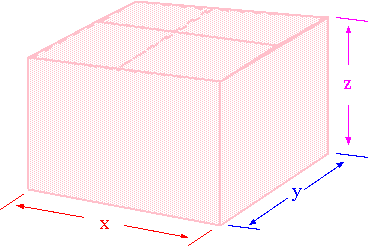
Example 1 A cardboard box
Find the dimensions of the largest cardboard box with a square base which uses only 12 square feet of cardboard. For a cardboard box, remember that the top and bottom have two layers of cardboard (for the flaps), while the sides are a single layer.

Begin by drawing a sketch of the box, and then label the sides which might vary, as say x , y , and z , where z is the height.

|
Now, you are given that S = 12 , so
|
Substitute these constraints in the original thing we wanted to optimize, and
|
|
This value of x , x = 1 , is the place where the maximum occurs. Why? Because the only place where there can be a maximum is where the derivative is 0, where the derivative doesn't exist, or the endpoints. Also, if there are endpoints of the interval that make even halfway sense, there must be a maximum. In this case the endpoints, x = 0 and x = 3 , both give V = 0 . So, x = 1 , giving V = 2 , must be the maximum. You find out which of the possible points is the optimum you want by evaluating the function at all the possible points.
By the way, you then should re-read the question to find out what is asked for. In this case, it asks for the dimensions of the box: x = y = 1 you already have. You then solve for z , using the constraint, z = 3/1-1 = 2 .
Copyright (c) 2000 by David L. Johnson.